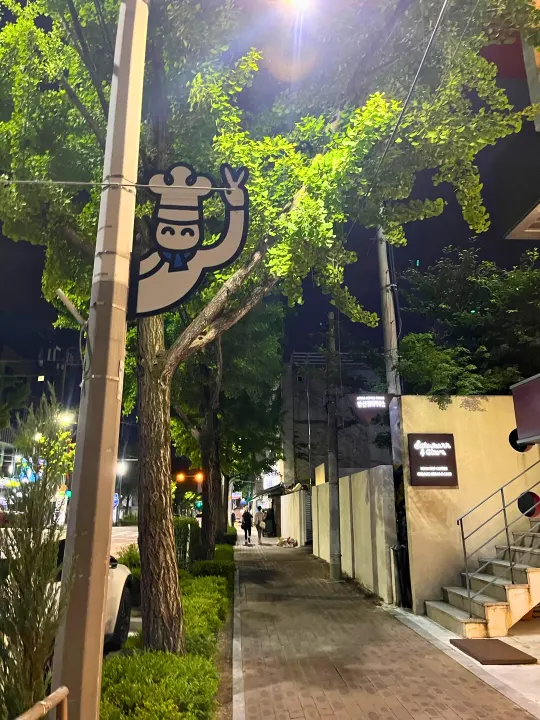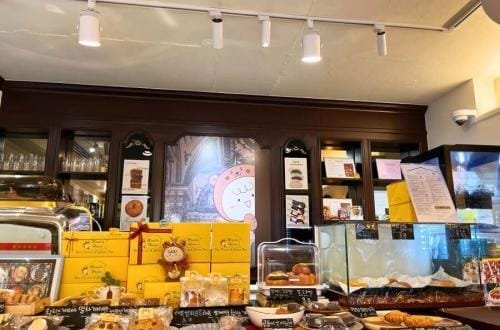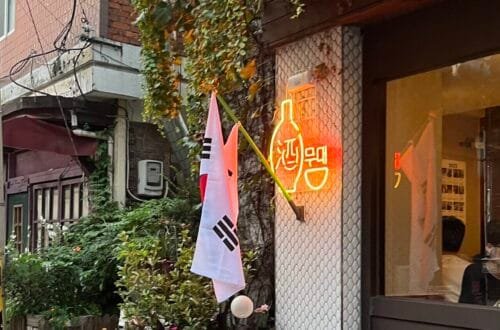
How to Survive Gluten Free in South Korea
*Please note that this is all based on my experiences. I am gluten intolerant but not highly allergic and cross contamination and small traces don’t affect me. Products that are described as 100% rice flour etc. therefore might a great option for intolerant people but not for someone who is sensitive to contaminations.
**I have been looking up some keywords like “gluten-free”, “food”/ “snacks” and “Korea” on the internet and was shocked how many sites provide false or only partly true information. Please don’t trust sources that say Kimchi or Korean noodles etc. are always gluten-free, because that’s not the case. I am not saying there are no reliable sources on the internet but please be careful .
Food to be careful about
Good news: most of the food and ingredients listed below are also available in a wheat/gluten-free versions in many supermarkets.
Bad news: most restaurants typically use those that do contain wheat or gluten.
Tip: Many Koreans have limited knowledge about gluten. Even if you mention you can’t eat Milkaru 밀가루 (Wheat flour) or Mil 밀 (wheat), they might be surprised and assure you that soy sauce, certain dishes like stew, or kimchi don’t contain wheat or gluten. While they mostly have only good intentions, this lack of awareness can sometimes be risky.
When asking about food, my go-to explanation is: “I cannot eat gluten.” This covers (wheat) flour, Kochujang, soy sauce, and most foods containing sauces.” That still doesn’t cover all possible gluten traps and also doesn’t save me from cross-contamination, but it is a good start. There is a Korean Celiac / Coeliac Gluten Free Restaurant Card on the internet for free, which even does a better job and also explains barley etc. Printing and carrying it around might save your life if you are highly allergic, but I have also seen a lot of restaurants turning people down because they couldn’t guarantee there was no cross-contamination. If you are not sensitive to cross-contamination and traces, it might be a good idea to cut off the lower part of the card about cross-contamination.
Remember that even cakes, rice cakes and bread which are labelled as made of rice flour may still contain some wheat flour. Using rice flour has become a health trend recently, but a lot of people are still unaware of food intolerances and allergies.
Thankfully, modern translation tools like Papago are incredibly helpful. So even if your Korean skills are not as advanced, if you know exactly what you have to ask for, you will be able to survive.

Food containing gluten:
- Soy sauce
- Kimchi in restaurants, since it is often mixed with wheat flour (even homemade Kimchi can contain wheat flour, but there are gluten-free versions at the supermarket.)
- Kochujang (red chilli paste) 고추장, since it often contains wheat or barley malt. (I know, the internet spells it “Gochujang” but a “K” is actually closer to the Korean pronunciation). There are two types of Kochujang. One is based on rice (and therefore slightly more expensive). The other one is based on wheat (therefore cheaper and favoured by restaurants).
- Ssamjang 쌈장, the sauce that is served mainly at bbq restaurants CAN contain gluten
- Doenjang 된장, fermented soybean paste CAN contain gluten
- Almost everything that comes with some sort of sauce because it most cases they either contain Kochujang or Soysauce
- Boricha 보리차 (Barley Tea)! If you get a free drink that is not water, it is mostly barley tea! (In Japan it is mostly green tea but some restaurants serve barley tea as a free drink as well. It is called Mugicha 麦茶.)
- Haemul Sundubu Jjigae 해물순두부찌개 Korean spicy seafood tofu stew is one of my favourites, but it contains soy sauce
- Kimchi-jjigae 김치찌개 since it contains Kimchi and Kochujang and you never know about those two
- Chicken (obviously)
- Makgeolli 막걸리 (Korean rice wine)
- Side dishes with seasoning because those also often contain soysauce
- Einspänner coffee → In might be gluten free in some places but I found out that the whipping cream at Twosome contains gluten and I sometimes had reactions on Einspänner at other cafes.
- Sausages can often contain wheat
- Ice cream in some cases
- Rice cakes in some cases
- Corn cheese →It is a side dish you will find in a lot of restaurants, but it might contain wheat and you might not find that out by asking the staff. I saw both, wheat-free and gluten containing versions at convenience stores
- Jokbal 족발 are braised pig’s trotters and while they are delicious they are also cooked in soy sauce
- Kalbi 갈비 are grilled beef short ribs and marinated in a sweet sauce containing soy sauce
Food to eat
Many of the dishes and ingredients mentioned above are available in gluten-free or wheat-free versions at most supermarkets. Pay close attention to the word Wheat 밀 (Mil). Also, please note that not every product clearly labels its allergens, such as freshly packed rice cakes at the supermarket. Syrup derived from wheat is often unmarked, and Mirin made from wheat-based vinegar has caught me off guard in both Japan and South Korea.
My recommendation: If you’re feeling curious and have the time, consider cooking some Korean dishes at home. You can find nearly all the necessary ingredients in a gluten-free version, and it may only cost you a few extra euros or dollars. For those on the go, stock up on essentials like gluten-free soy sauce and Ssamjang for BBQ. Buy small, affordable containers at Daisoo and carry them with you when dining out. (Daisoo is Korea’s version of a 1 Euro/1 Dollar shop, only better.)

Gluten-free/Wheat-free food:
(I call it gluten-free/wheat-free food, because even if it doesn’t contain gluten as an ingredient, some of them might contain traces or might be manufactured in factories that also process glutinous ingredients, which makes those products not safe enough for someone with a celiac disease.)
- Joseon Soysauce 조손 간장 (Joseon Kanjang)→ Traditional soy sauce mostly doesn’t contain gluten and is way cheaper than ordering “gluten-free” soy sauce online!
- Kimchi (just check for “mil” 밀 or use the translation app Papago to scan the product)
- Kochujang (red chili paste) 고추장
- Ssamjang 쌈장
- Doenjang 된장
- Soju (alcohol) and in most cases flavored soju. There are still some types like Starlight Chungha Sparkling that contain wheat though.
- 100% rice flour desserts
- 100% rice flour chicken (but often not the sauces they serve with it)
- Vietnamese rice noodle soup (but make sure to check the base)
- Yukhoe 육회 is raw minced meat, mostly beef and is often served in sesame oil, with an egg yolk, cheese stripes and sometimes pear. Soy sauce is sometimes used, so make sure to double-check!
- Sushi (bring your own soy sauce and check the wasabi if possible. Though, wasabi mostly doesn’t contain gluten, and sometimes I just take the risk.)
- Yakitori. This is actually a Japanese dish, but since Japanese food and Izakayas are a growing trend in Korea, it is not hard to find it. Yakitori 焼き鳥 are chicken skewers. Some come with a sauce (which mostly contains gluten!) but those without, seasoned with salt and pepper, are really delicious too!

For today, I’m out of ideas, but I promise to keep this list updated! Please tell me in the comments if you have any other recommendations or experiences :))





5 Comments
Elsa
Hi, thanks for your suggestions!
I am celiac and I am visiting Seoul next month, I am very scared about food.
Do you have a list of recommended korean dishes in restaurants that are naturally gluten free ?
Thanks!
glutenfreeinseoul.com
Hi, thank you for your comment! 🙂
I think it really depends on where you eat and on how much you are affected by cross contamination and traces. In case you have to be very careful, I would recommend to mostly eat at restaurants that call themselves gluten-free, because that means they know what gluten is (which is still rare). In general, if you eat meat you can eat Korean BBQ, as long as it has NO sauce! And try to be careful about side dishes, as I mentioned in this blog :), But as I said, in the end it really depends on the restaurant.
If you like soups, Seollongtang works too, but only if you order it without noodles (noodles= Kukssu 국수. You can say “Kuksu bbae juseyo 국수 빼주세요” which means please serve without noodles).
If you like Korean BBQ, there are probably a lot of possible places, but I liked and had some good experiences last year at Maple Tree House in Samcheong-dong (less crowded than Itaewon plus the palaces, hanok village and some traditional cafés are in close vicinity). Not all the servers speak English, but in the kitchen is full-time staff which does. I guess it depends on who works, but especially the Canadian chef is very kind and helpful.
If it comes to non-Korean food, Sashimi or Yakitori (chicken skewers) without sauce are fine too. But be careful if you order something like a Sashimi bowl, because some restaurants put Soy sauce in it or even use a vinegar that might contain gluten.
I think if you want to be 100 % sure and have a plan B just in case, staying at an Airbnb with a small cooking corner might be good. Or visit some gluten-free bakeries and get some bread to go (it might be sweeter than you are used to, but even as a German I still like it! haha). Or look for Pho Thit Bo Rice Noodles with beef (https://ijakkaya.tistory.com/515) (chicken is fine too) in bigger supermarkets like Homeplus. I´m not sure about cross contamination, but they don’t contain any wheat.
I hope you have a nice trip! 🙂
glutenfreeinseoul.com
Oh, and there is also a celiac explanation card in Korean, which you can print out and show to people at restaurants, so they can understand your allergy better!
https://www.celiactravel.com/file_uploads/cards/korean-gluten-free-restaurant-card.pdf
It says, that the person carrying it is heavily allergic, so in case you are, it might be a life savior.
In case you are not and only experience light symptoms, it might depend. At some restaurants it might help. At others, the staff might get scared and just turn you down, because they don’t really understand allergies and fear to make a mistake. But all in all, the card explains very detailed what might contain gluten (Soy sauce, Chili paste etc.) and what doesn’t (cheese, potatoes etc.) so I’d advise to print it and take it with you 🙂
Almudena
Hi, do you know if the Chum Churum Peach Soju contains gluten? I really want to try it but I am afraid of getting a reaction as I am celiac, thanks :)!!!
glutenfreeinseoul.com
Hey! I looked it up on the internet, but it seems like it is mostly sold overseas (more than in Korea) and I didn’t find a picture of the back label with the ingredients. You can check if you see something on the back about allergens and ‘밀’ or maybe scan it with Papago (Korean translation app) but even in that case I would be careful. It might contain traces of gluten, which might be dangerous for a celiac person. Also, I’ve seen Makgeolli in Asian supermarkets in my country (Germany) where the English label stated it didn’t contain gluten even though it actually did, so maybe be careful about some translated labels! I have been drinking similar flavoured sojus (strawberry, plum) and didn’t have a reaction, but I am also not celiac only intolerant (Sorry I’m not really much of a help with this one).